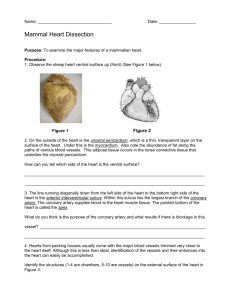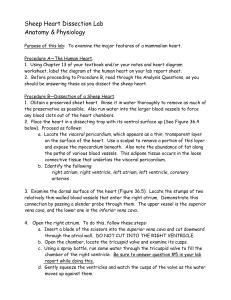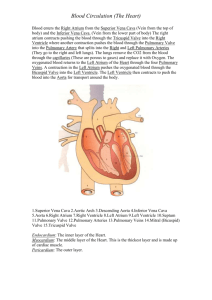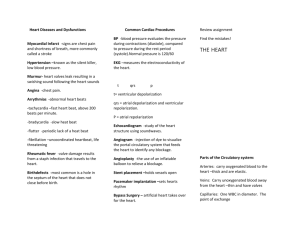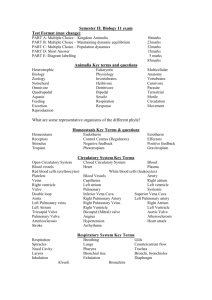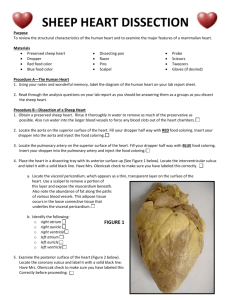Worksheet
advertisement
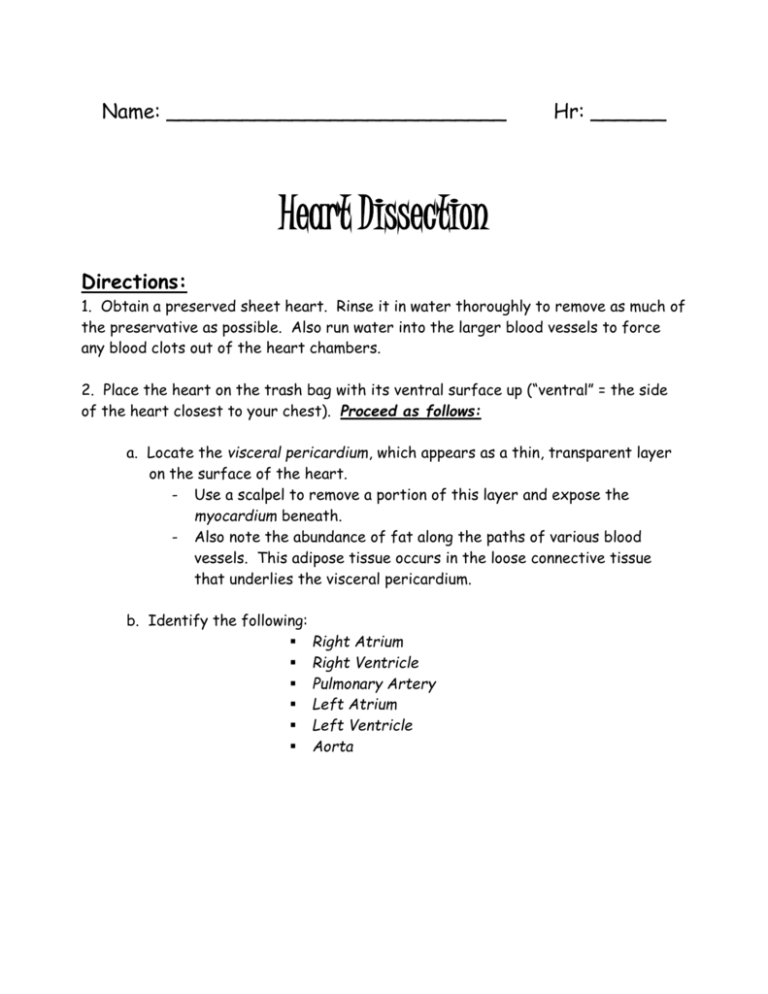
Name: ___________________________ Hr: ______ Heart Dissection Directions: 1. Obtain a preserved sheet heart. Rinse it in water thoroughly to remove as much of the preservative as possible. Also run water into the larger blood vessels to force any blood clots out of the heart chambers. 2. Place the heart on the trash bag with its ventral surface up (“ventral” = the side of the heart closest to your chest). Proceed as follows: a. Locate the visceral pericardium, which appears as a thin, transparent layer on the surface of the heart. - Use a scalpel to remove a portion of this layer and expose the myocardium beneath. - Also note the abundance of fat along the paths of various blood vessels. This adipose tissue occurs in the loose connective tissue that underlies the visceral pericardium. b. Identify the following: Right Atrium Right Ventricle Pulmonary Artery Left Atrium Left Ventricle Aorta 3. Examine the dorsal surface of the heart (the side closest to your back). - Locate the stumps of two relatively thin-walled blood vessels that enter the right atrium. - Demonstrate this connection by passing a slender probe through them. - The upper vessel is the superior vena cava, and the lower one is the inferior vena cava. 4. Open the right atrium. To do this, follow these steps: a. Insert a blade of the scissors into the superior vena cava and cut downward through the atrial wall (Figure 36.5). b. Open the chamber, locate the tricuspid valve and examine its cusps. c. Using a spray bottle, run some water through the tricuspid valve to fill the chamber of the right ventricle. d. Gently squeeze the ventricles and watch the cusps of the valve as the water moves up against them. 5. Open the right ventricle as follows: a. Continue cutting downward through the tricuspid valve and the right ventricular wall until you reach the apex of the heart. b. Find the opening to the pulmonary trunk and use the scissors to cut upward through the wall of the right ventricle. Follow the pulmonary trunk until you have exposed the pulmonary valve. c. Examine the valve and its cusps. 6. Open the left side of the heart. To do this, follow these steps: a. Insert the blade of the scissors through the wall of the left atrium and cut downward to the apex of the heart. b. Open the left atrium and locate the four openings of the pulmonary veins. Pass a slender probe through each opening and locate the stump of its vessel. c. Examine the bicuspid valve (mitral valve) and its cusps. d. Also examine the left ventricle and compare the thickness of its wall with that of the right ventricle. 7. Locate the aorta, which leads away from the left ventricle, and proceed as follows: a. Compare the thickness of the aortic wall with that of the pulmonary trunk. b. Use scissors to cut along the length of the aorta to expose the aortic valve at its base. c. Examine the cusps of the valve and locate the openings of the coronary arteries just distal to them. 8. As a review, locate and identify the stumps of each of the major blood vessels associated with the heart. 9. Throw the heart in the trash. 10. Answer the questions Heart Dissection Questions!! Label the diagram of the human heart below. 1___________________________________ 2. __________________________________ 3. __________________________________ 4. __________________________________ 5. __________________________________ 6. __________________________________ 7. __________________________________ 8. __________________________________ 9. __________________________________ 10. _________________________________ 11. _________________________________ 12. _________________________________ 13. _________________________________ 14. _________________________________ 15. _________________________________ Analysis Questions 1. How can you tell which side of the heart is the ventral surface (the surface closer to your chest)? 2. How many chambers are found in the mammalian heart? List these chambers. 3. Which chambers are the pumping chambers of the heart? 4. Which chambers are the receiving chambers of the heart? 5. Describe the action of the tricuspid valve when the ventricle is full. 6. Compare the structure of the tricuspid valve with that of the pulmonary valve. 7. How do the walls of the atria compare with the walls of the ventricles and why are they different? 8. What is the purpose of heart valves? 8. Name & compare the heart valves found between the upper & lower chambers of the right and left sides of the heart. 9. Vessels that carry blood away from the heart are called __________, while __________ carry blood toward the heart. 10. Which artery is the largest and why? 11. The Left Pulmonary Artery can also be called your Left Coronary Artery. What would happen if this was blocked by a blood clot? 13. Using words and Arrows: Trace blood flow through the major blood vessels and heart, starting with deoxygenated blood returned from the body. VENTRAL SURFACE DORSAL SURFACE Cutting Through the Right Ventricle (Cutting the Heart in ½)
